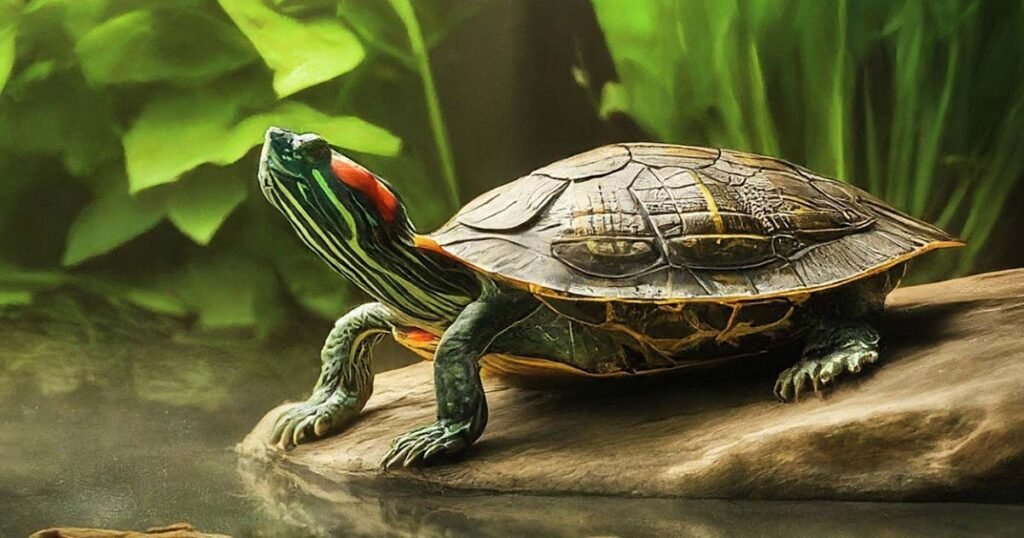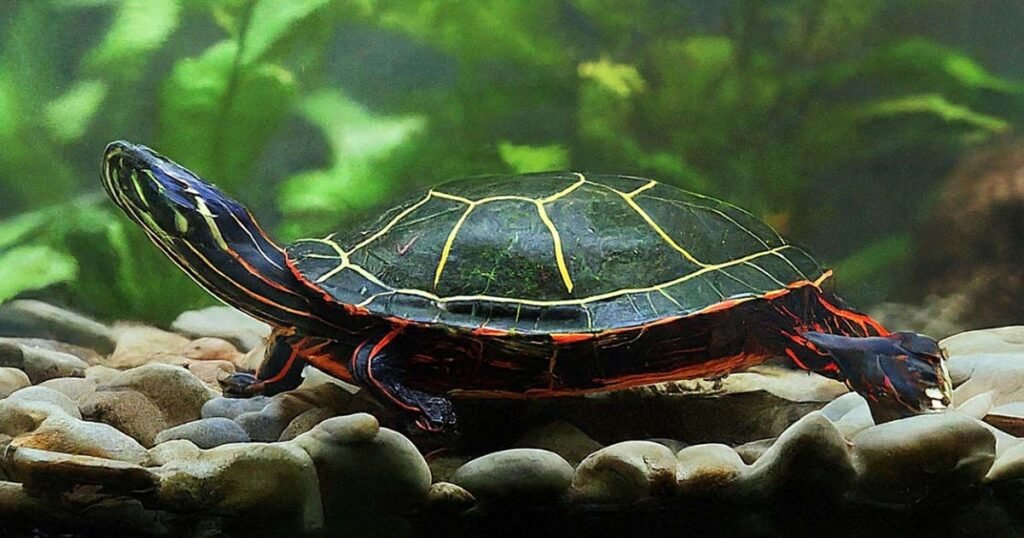Turtles are naturally peaceful creatures, and one of their most significant features is that they are unsocial. It means they don’t interact much, so their few to no expressions make turtle owners wonder: “Do turtles have emotions?” The answer is simple: any other animal, like humans, shows its reaction when it feels anything. Like many creatures, turtles also feel.
Now, turtles can have two types of feelings. One is related to bodily reactions, like if they get hurt or sick, and another is related to emotions like happiness, anger, or fear. Emotion is mainly associated with the mind state. So, let’s deep-dive into this question: Do turtles have emotions? If they do, how do emotions work for them?
Do Turtles Have Emotions?

Yes, turtles have emotions, but to a shallow extent. According to recent scientific studies, turtles feel a more superficial or more minor range of emotions. These emotions include anger, fear, relaxation, depression, stress, etc.
However, turtles can also feel pain or sickness, and these feelings are not directly related to their emotions. They are mainly connected to their body’s reaction.
One notable point is that turtles’ emotions are not like humans. They can not feel happy like we do, yet they feel content when everything matches their requirements, such as their habitat, environment, food, etc.
How Turtles Express Their Emotional Feelings?

Turtles could be more interactive and expressive, as we already stated above. So, it takes work to understand their emotional condition. They don’t have expressive faces to show happiness or frown at frustration. But turtles actually communicate their emotional state in subtle ways, and with a bit of practice, you can learn to crack their emotional code.
Body Language Basics
The body signs of a turtle display its feelings. When a turtle lies in the sun with its legs spread, it’s probably content and relaxed. On the other hand, a turtle that pulls entirely into its shell might be scared or stressed. Even their swimming patterns can be clues. A turtle darting around the tank could be feeling energetic or even a little anxious.
Other Signs
Turtles can also use their appetites to express themselves. A turtle that joyfully gobbles up its food is probably feeling good and healthy. However, a turtle who refuses to eat for a while might feel unwell or stressed.
It’s important to note that some behavior changes could be signs of illness. If you’re ever concerned about your turtle’s health, always consult a veterinarian.
Watch your turtle’s body language, appetite, and activity level to figure out how they’re feeling. Remember, it’s all about the little details of your turtle. The more you watch your turtles, the easier it will be to figure out their unique communication style or emotions.
Emotional States and Corresponding Behaviors in Turtles
| Emotional Reaction | Behaviors and Signs |
| Content/Relaxed | Active swimming, basking in the sun, eager eating, bright eyes, playful interaction |
| Curious | Investigating their environment, showing interest in new stimuli, and alert body language |
| Distressed/Sad | Decreased appetite, lethargy, withdrawal from the environment, avoiding interaction with caretakers |
| Lethargic | Unusually tired, lack of energy, spending more time hiding, moving slowly |
| Withdrawn | Avoiding interaction with their environment, avoiding human caretakers, spending more time hiding, reducing playful behavior |
| Aggressive | Snapping or biting, signs of irritability or frustration |
How Turtles Sense Physical Feelings
Turtles might seem tough in their shells, but they actually feel some basic body sensations. Their bodily sensations are not directly related to their mental state. Their bodily reactions or feelings start with tiny helpers called nociceptors.
Nociceptors are special nerve cells throughout a turtle’s body. They are a standard nerve system among many animals. They’re like tiny alarms that can detect sensations that might hurt, like extreme temperatures, bumps, or pinches. When a nociceptor senses something unpleasant, it sends a signal to the turtle’s brain.
The brain then interprets this signal and decides what to do. It might involve pulling away from the discomfort, like a turtle retreating into its shell when it feels too hot. Nociception is like a built-in safety system that helps turtles avoid getting injured.
Positive Emotions Of Turtle?

Do Turtles Feel Happy?
Turtles may not wag their tails or jump for joy, but that doesn’t mean they can’t be happy. They feel a more straightforward form of happiness, more like contentment. You can think of it like this: A happy turtle is a turtle with all its needs met. It has a warm basking spot, a full belly, and feels safe in its environment.
A happy turtle will bask in the sun for hours on end, swim actively, and explore its surroundings with curiosity. In other words, turtles can experience happiness, even if it looks different from ours.
Negative Emotions Of Turtle?
Do Turtles Feel Sad
Turtles might not shed tears, but can they experience sadness? The answer is more than a simple yes or no. Scientists are still learning about reptile emotional range, and sadness is a complex emotion.
While turtles likely don’t feel sadness like humans, they may experience discomfort when their world is disrupted. It could be caused by things like a dirty tank, a change in their environment, or even a lack of interaction.
Turtles who are feeling off or sad might have decreased appetites, lethargy, or withdrawn behavior. Take a look at their environment if you notice these changes and make sure their needs are met.
Do Turtles Feel Pain?
Turtles feel pain like any other creature, and this feeling is mainly because of body reaction. Even though turtles might seem challenging in their shells, feeling pain is a common reaction for them.
Just like other animals, turtles have tiny receptors throughout their bodies called nociceptors. If their shell gets scraped or their tail gets pinched, these act like alarms. In the above section, we discussed nociceptors and turtles’ physical sense.
Turtles might not whimper or cry out in pain like some animals, but their bodies still tell them something’s wrong. Understanding this is essential for caring for our turtle friends properly.
Do Turtles Cry?
Yes, they can cry, but not like we do during sadness or pain. While it might look like your turtle is crying its heart out, there’s a different reason behind those wet cheeks.
Sea turtles are seen crying. They have special glands near their eyes that let them get rid of excess salt. Since they live in salty ocean water, their bodies need a way to balance things out. These glands release extra salt in a teardrop-like liquid. So, while it might look like a sad situation, it’s actually a clever adaptation for survival.
Do Turtles Feel Angry?
Turtles might not throw mini tantrums, but that doesn’t mean they can’t get angry. While they don’t experience anger like humans, they can exhibit behaviors that show they’re feeling irritated or stressed.
If a turtle feels threatened or annoyed, it might hiss, retreat into its shell for protection, or even try to nibble. These actions are their way of saying, “Back off!” You should understand these signals so you don’t upset them.
Do Turtles Get Bored?
Turtles might seem content floating around in their tank, but can they get bored? The answer is yes, they can. It’s not the same thing as human boredom. But turtles get restless when their environment isn’t stimulating enough.
Imagine a turtle with nothing to do all day—no hiding spots to explore, no basking platforms to climb, and no tasty treats to hunt for. A bored turtle might become less active or repetitive. So, keeping your turtle’s environment interesting is key to avoiding boredom.
Do Turtles Feel stressed?
Even though boredom and stress can seem similar (think staring at the same wall all day! ), turtles feel them differently. Boredom is a lack of stimulation, but stress is a reaction to a perceived threat. Eventually, boredom can make turtles feel stressed.
- A dirty tank can be stressful for a turtle.
- Fluctuations in these temperatures can cause stress.
- Turtles need peace to feel secure. Noisy environments can often be stressful for them.
Signs of stress in turtles include:
- When stressed, turtles might stop eating.
- A stressed turtle might stay hidden in its shell for extended periods.
- If your turtle is darting around the tank madly, it might be stressed.
Scientific Perspective on Turtles Emotion

Science is digging deeper into turtles or any other animal’s emotions, and it turns out they’re complicated.
Scientists Shifting Focus from Fear to Fun Emotion
In the past, scientists focused on understanding negative emotions in animals (such as turtles), like fear and pain. It helped improve animal welfare, but it left an open question mark: Can animals experience positive emotions, too? So, the focus of the study is shifting. Now, scientists are more likely to be interested in finding out details about animals’ positive emotions.
Turtles Can Feel Different Kinds of Feelings
Recent research suggests turtles experience a range of emotions, even if they’re simpler versions of ours. It could include basic feelings like fear and contentment and even complex emotions like depression.
Turtles do not express their feelings much like other animals do. It’s hard to understand their emotions because they express them subtly, as we mentioned above. But turtles feel emotions, even if to a lesser degree.
FAQs
Do turtles have feelings and emotions?
Turtles experience emotions in a simpler way than humans. You can see their happiness through basking or activity and their stress through hiding or refusing food. Likely, they don’t feel emotions as intensely as humans, but they still have moods.
Do all turtles have emotions?
Yes, most turtles do feel emotions. Although scientists aren’t sure about turtles’ emotional range, they’re most likely not like humans. It’s really difficult to find out their exact Emotions, as they lack interactivity. But, yes, in some subtle manner, their Emotions are noticeable by turtle owners.
Do sea turtles have emotions?
Deep sea turtles feel emotions but in their way. Their feelings are more about comfort or stress based on their environment. Sea turtles cry for their health need rather than their emotional state. They tend to release their bodies extra salt to adapt to their salty water environment.
Sea turtles are relaxed when they’re swimming in a calm, familiar place. However, a polluted or crowded space might make them feel stressed. While their emotions might not be as complex as ours, sea turtles still experience a range of feelings based on their surroundings.
Do turtles have emotional feelings?
Yes, turtles have emotional feelings to a minimal extent. But they sense health-related feelings like other animals, such as pain, sickness, and fear. Turtles also feel stress, boredom, and other emotions.
Read More: Why Do Turtles Dig Holes?
Wrapping Up
So, do turtles have emotions? Turtles feel emotions but in a turtle-like way. We might cheer when we’re happy, but a happy turtle might bask in the sun all chill.
Science is studying turtle feelings constantly, but it seems they can feel happy, stressed, and maybe even relaxed. If we understand these simple emotions, we can ensure our turtles have a comfortable home and meet all their needs. A happy turtle is a healthy turtle, and that’s something to enjoy as a pet owner.
